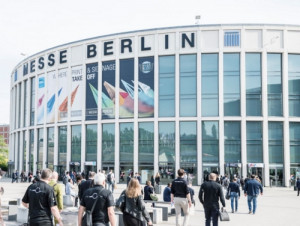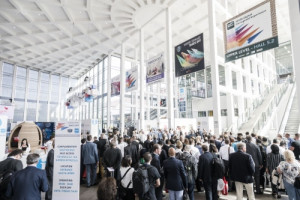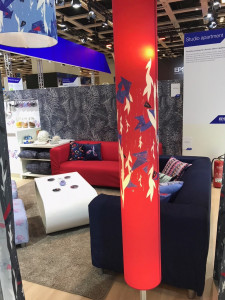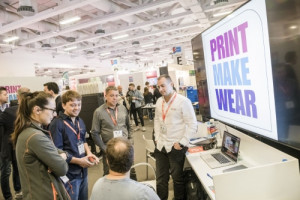 FESPA Global Print Expo 2018 attracted visitors from a record 142 countries. Following the 2017 shift to an annual event cycle and the decision to amalgamate the flagship show with its FESPA Digital ‘spin-off’, FESPA 2018 also attracted the largest number of visitors ever for a four-day FESPA show, with 20,442 individual visitors to FESPA and the co-located European Sign Expo 2018.
FESPA Global Print Expo 2018 attracted visitors from a record 142 countries. Following the 2017 shift to an annual event cycle and the decision to amalgamate the flagship show with its FESPA Digital ‘spin-off’, FESPA 2018 also attracted the largest number of visitors ever for a four-day FESPA show, with 20,442 individual visitors to FESPA and the co-located European Sign Expo 2018.
Tradefairs and Events | by Marion Zuurveen
The number of visitors showed a 22% increase compared to the number of individual visitors to FESPA Digital 2016 (Amsterdam), FESPA’s last fourday event. Two-thirds of all visitors dedicated more than one day to the event to cover the ten exhibition halls and take advantage of the expanded content program, including European Sign Expo, the FESPA Trend Theatre, an enlarged Printeriors showcase, the new Print Make Wear garment production feature and the first-ever Digital Corrugated Experience for packaging and point-of-sale.
The Digital Corrugated Experience showed new possibities for printers aimed at the growing demand for personalized packages. Repeat visits brought the total event attendance to 33,799.
 Visitors
Visitors
Germany delivered the largest percentage of visitors overall, with 26% of the total audience coming from the host country. After Germany, the top ten countries in terms of visitor attendance were the United Kingdom, Poland, Italy, the Netherlands, Spain, France, the Czech Republic, Switzerland, Belgium and Sweden.The fact that there was such a high number of Polish visitors in particular reflected the accessibility of Berlin for printers from across the border.
According to the event registration data, for 44 % of all visitors, the dominant area of visitor interest was digital printing. FESPA’s sustained coverage of innovations in textile printing well met the interest in textile and fabric printing indicated by one in three 2018 visitors. Commercial print, finishing, design to print, sublimation printing and industrial printing also featured particularly strongly among visitors’ priorities for the event.
FESPA Exhibitions Director Roz Guarnori commented: “FESPA 2018 Global Print Expo was a vibrant, action-packed event that absolutely surpassed even our own expectations, from the energy and appetite for innovation among our diverse visitor audience to the incredible range of new products brought to market by our exhibitors. Our own research and the electric mood of the show reinforce our confidence that specialty print and signage are sectors that never stop inventing, exploring, pushing boundaries and looking for new ways to achieve growth.”
She continued: “When we announced the change to an annual four-day FESPA event cycle, we fully expected to see some ‘levelling off’ of attendance between the historical flagship FESPA event and the four-day Digital event.
Against these expectations, we are absolutely thrilled to have welcomed just as many visitors as we did over five days in Hamburg in 2017, and to have exceeded typical attendance at a FESPA Digital show by over a fifth.
With 35% of visitors having final decision-making responsibility in their businesses, and the same proportion of the audience coming primarily to research or purchase new equipment, it’s clear that FESPA is viewed all over the world as a leading showcase of latest technology for digital, screen and textile print and a vital event in informing critical investment decisions.”
 Printeriors
Printeriors
The Printeriors showcase at the show entrance showed what a future airport lounge could look like in 2030. All visitors could relax and view examples of beautiful printed home and living accessories such as lamps, chairs and wallpapers. At many stands, as for example at the Epson stand, visitors could also look at nice examples of printed home decoration accessories and accessories for hotels and restaurants.
2018 Print Census
During the show, the headline findings of FESPA 2018 Print Census were announced. The Print Census was conducted in partnership with InfoTrends, a division of Keypoint Intelligence.1405 respondents from 102 countries participated in the research, allowing for a significantly broader geographical reach than the 2015 research had (+59%).
The latest Print Census collected data from a diverse range of print businesses who defined their business focus as: digital printing (17%), screen (15%), sign and display (10%), textile fabric and direct-to-garment (10%), commercial print and reprographics (13%), graphic arts and creative (11%) and packaging (4%). Analysis of the data showed that the key trends which had been revealed by the 2015 research are just as strong in 2018. In many cases they are even more prevalent, fuelled by continued economic recovery and the positive impact of technology in support of mass-customisation.
The optimism reflected in the 2015 responses was reinforced in 2018: 83% of respondents state that they are optimistic about the future of their businesses (2015: 80%). This is wellfounded by a continuous growth in businesses with digital wide format and respondents reporting a CAGR of 4.2% since 2007. Today, digital output represents 44% of total revenues, and is forecast to grow to 53% of turnover within two years.
Print’s ongoing redefinition as a customer-driven service industry is even more pronounced today than it was three years ago, as businesses meet the continued trend to mass customization. 72% now report increasing demand for fast turnaround, 61% see growing requirement for short runs and 59% observe rising expectations of just-in-time delivery (JIT).
Print businesses continue to respond to sustained customer demand for fast turnaround, short runs and JIT delivery with strategic digital technology investments. In the face of volume growth, increased capacity is now a key investment priority. 54% of respondents cite this as their main motivation for capital spend (2015: 34%). Cost reduction is a factor for 53%, while diversification into new markets and product offerings remains a focus of investment for 53% of those surveyed.
Growing textile segment
The 2018 Print Census was developed to arrive at a more detailed picture of the growing textile segment. Garment products dominate across all textile businesses, with sports apparel, textiles for garments and fast fashion topping the growth applications ‘leader board’. Digital adoption for textile is slower than in other segments. Across all textile-related segments, production is still dominated by analogue processes. However, among printers focused on textile, 56% have made digital investments and 19% plan to do so in the next two years, aiming to reap the benefits of reduced time to market customised creative collections, prototyping and a positive impact on environmental footprint by water and energy consumption reduction.
Production speed is an investment priority for 69% of textile respondents. 55% want the ability to print directly onto untreated materials. These investments are motivated by brand owner demand for timesensitive production that delivers supply chain improvements such as waste reduction, optimises response to seasonal peaks and enables local delivery.
Screen and textile printers expect digital’s contribution to textile printing revenues to grow by 12% in the next two years.
Sustainability
The 2018 Census question set was expanded to acquire up-to-date insights into the importance of environmentally sustainable production. Responses show that environmental investments are heavily influenced by customer expectations regarding sustainable manufacturing and materials. 76% say that customer demand for environmentally sound products is shaping business strategies, with more than one in five stating that it is a major influence.
The next FESPA Global Print Expo takes place at Messe Munich, Germany, from 14 to 17 May 2019. FESPA has also confirmed the location and dates of the 2020 edition. This show will be held from 24 to 27 March 2020 in Madrid, Spain. All the show news can be found in our file. You can also view the photo gallery.
Further information about FESPA events can be found at www.fespa.com.









